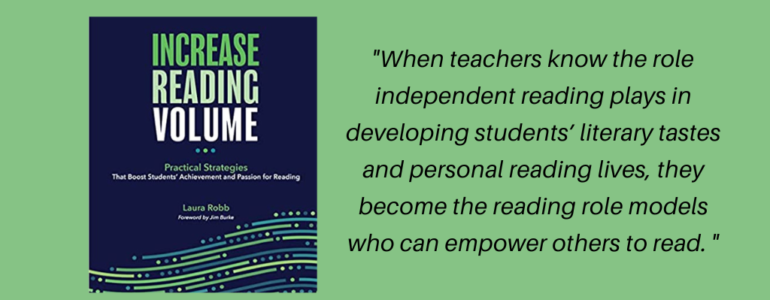By Laura Robb –
Robbie, a fifth grader, loves to read and always has a self-selected independent reading book on his desk. He tells me that if the book’s close by, he can read it after finishing class work. Frequently, Robbie’s book travels home with him when he’s “into it and can’t stop reading.” Most days, Robbie reads more than one hour: twenty minutes during independent reading at school and up to one hour at home. It’s no surprise that Robbie scores high in reading comprehension and vocabulary on annual state tests. The volume of reading he does allows Robbie to read more than two million words a year, and he enlarges his vocabulary by experiencing how words work in diverse contexts and situations.
The research of Richard Allington (2014), Steven Krashen (2004) and the scientific study of the benefits of voluminous reading by Samuels and Wu (2004) reveals a high correlation between time spent on independent reading and students’ achievement. Access to books, culturally relevant classroom libraries and time to read at school can make a difference in students’ reading growth and achievement.
In 1977, Richard Allington wrote this article: “If They Don’t Read Much, How They Ever Gonna Get Good?” and his words still ring true today! Forty-six years have passed since Allington published his article, and a quick “fix-it” program for literacy instruction still doesn’t exist. According to the Scholastic Teacher & Principal School Report, only 36% of teachers set time aside for independent reading and/or read-aloud every time class meets. Nearly two in three teachers (63%) say they wish they had time for independent reading, and even though many schedules it as the last learning experience, time runs out, and students don’t read.
There are school districts where administrators still believe that allowing students to read in class is an ineffective use of instructional time. Yet, these school leaders usually understand that students must practice daily to develop an outstanding school sports team or band. The same is true for reading: daily practice is critical for success. A school-wide belief that volume in reading matters starts with the principal, who can rally teachers, students, and parents around an independent reading initiative by doing the following:
- Finding funds for culturally relevant classroom libraries and ensuring that all English Language Arts teachers have libraries for students to self-select books they can and want to read.
- Setting aside funds to annually update classroom libraries and encourage teachers to ask students for suggestions for new books, turning the library into “our library.”
- Showing the support of teachers and students by visiting classes to celebrate the independent reading of self-selected books.
- Creating class schedules that have enough time for independent and instructional reading at school.
- Finding the time in a busy schedule to read aloud to classes and send this message to faculty and students: I value and enjoy reading!
Developing a Culture of Reading
Support from the principal can make a huge difference in how teachers feel about students reading at school. When teachers know the role independent reading plays in developing students’ literary tastes and personal reading lives, when teachers are readers who enthusiastically share their book love with students, they become the reading role models who can empower others to read.
If students look forward to independent reading at school and develop the stamina to concentrate deeply for 30 minutes, they are more likely to read at home. Moreover, a combination of daily reading at school and at home can result in students “meeting” up to three to four million words a year. The ever-increasing reading mileage measured on students’ “book odometers” ensures they meet words used in diverse contexts, resulting in continual vocabulary growth. In addition, they build background knowledge of how topics and genres work, develop fluency, learn new information and concepts, and experience the pleasure of discussing books with peers. However, students need access to books at school and home to continually grow as readers and thinkers.
Access is Key
When students have access to books through classroom libraries and their school’s media center, they can return a completed book and then check out a new one as they shop for books in their classroom libraries. A strong school media center with a certified librarian is also important to students’ growth as readers because it offers a larger book collection with more choices and an expert who has a deep knowledge of the collection to share with and support teachers and students.
According to a study in The Handbook of Early Literacy Research, Volume 2, editors: Susan Neuman and David Dickinson note that (page 31, 2006), in low-income neighborhoods, the ratio of age-appropriate books per child is 1 book for every 300 children. Research cited by Alia Wong (2016) supports studies completed in 1996 and 2013: 61% of low-income families with children have no children’s books in their homes, and only 61 percent of poor families with young children have internet-enabled mobile devices. In addition, according to Wong’s Atlantic article “Where Books Are All But Non-Existent” (2016), poor families tend to underutilize public libraries, whether it’s because they worry about being charged late fees or they’re reluctant to put their name on a card or due to their lack of experiences with public libraries, they don’t use them.
Because a large percentage of families living in poverty don’t have books at home, the responsibility of developing access falls to principals, teachers, and the school librarian, who can encourage students to take books home during the summer, on school nights, weekends, and over holidays. If you want your students to love reading and choose reading at school and home, they need continuous access to a wide range of books that will keep them engaged throughout the year.
Closing Thoughts

It’s time to recognize that access to books for all children and scheduling independent reading of self-selected books each time class meets is an effective, research-tested way to increase students’ reading achievement and love of reading! To become readers, children need to read books they choose—books they can and want to read- that are relevant to their lives! Yes, reading volume matters!
References
Allington, R. L. (1977). “If they don’t read much, how they ever gonna get good? Journal of Adolescent & Adult Literacy. Newark, DE: IRA, 21 (1), 57-61.
———. “How Reading Volume Affects Both Reading Fluency and Reading Achievement.” International Electronic Journal of Elementary Education, vol. 7, no. 1, 2014, pp. 13–26.
Krashen, Stephen D. The Power of Reading: Insights from the Research. 2nd ed., Libraries Unlimited, 2004.
Neuman, S. B. “The k\Knowledge Gap: Implications for Early Education.” Handbook of Early Literacy Research, volume 2. Editors: Dickinson, D.K . & Neuman, S. B. New York, NY: Guilford Press, 29-41.
Samuels, S. Jay, and Yi-Chen Wu. “How the Amount of Time Spent on Independent Reading Affects Reading Achievement: A Response to the National Reading Panel.” CiteSeer, Jan. 2001, http://citeseerx.ist.psu.edu/viewdoc/summary?doi=10.1.1.539.9906.
Wong, Alia (2016). “Where Books Are All But Non-Existent.” In The Atlantic. https://www.theatlantic.com/education/archive/2016/07/where-books-are-nonexistent/491282/
Follow Laura on Twitter @LRobbTeacher
Check Laura’s Newest Book – Volume in Reading Matters
![]()













